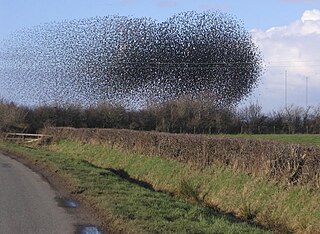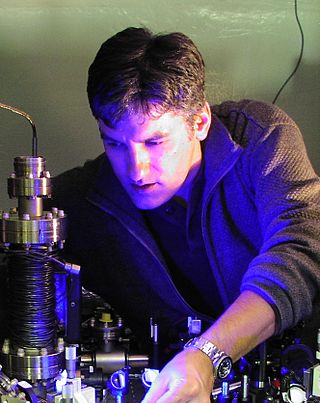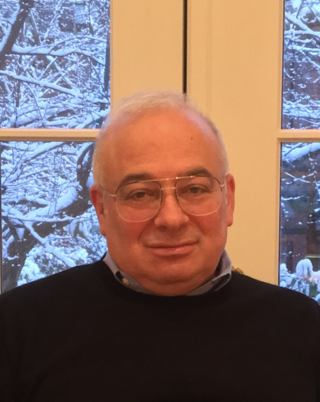
A colloid is a mixture in which one substance consisting of microscopically dispersed insoluble particles is suspended throughout another substance. Some definitions specify that the particles must be dispersed in a liquid, while others extend the definition to include substances like aerosols and gels. The term colloidal suspension refers unambiguously to the overall mixture. A colloid has a dispersed phase and a continuous phase. The dispersed phase particles have a diameter of approximately 1 nanometre to 1 micrometre.

Soft matter or soft condensed matter is a subfield of condensed matter comprising a variety of physical systems that are deformed or structurally altered by thermal or mechanical stress of the magnitude of thermal fluctuations. These materials share an important common feature in that predominant physical behaviors occur at an energy scale comparable with room temperature thermal energy, and that entropy is considered the dominant factor. At these temperatures, quantum aspects are generally unimportant. Soft materials include liquids, colloids, polymers, foams, gels, granular materials, liquid crystals, flesh, and a number of biomaterials. When soft materials interact favorably with surfaces, they become squashed without an external compressive force. Pierre-Gilles de Gennes, who has been called the "founding father of soft matter," received the Nobel Prize in Physics in 1991 for discovering that methods developed for studying order phenomena in simple systems can be generalized to the more complex cases found in soft matter, in particular, to the behaviors of liquid crystals and polymers.
Harry Leonard Swinney is an American physicist noted for his contributions to the field of nonlinear dynamics.

A colloidal crystal is an ordered array of colloidal particles and fine grained materials analogous to a standard crystal whose repeating subunits are atoms or molecules. A natural example of this phenomenon can be found in the gem opal, where spheres of silica assume a close-packed locally periodic structure under moderate compression. Bulk properties of a colloidal crystal depend on composition, particle size, packing arrangement, and degree of regularity. Applications include photonics, materials processing, and the study of self-assembly and phase transitions.
Diffusing-wave spectroscopy (DWS) is an optical technique derived from dynamic light scattering (DLS) that studies the dynamics of scattered light in the limit of strong multiple scattering. It has been widely used in the past to study colloidal suspensions, emulsions, foams, gels, biological media and other forms of soft matter. If carefully calibrated, DWS allows the quantitative measurement of microscopic motion in a soft material, from which the rheological properties of the complex medium can be extracted via the microrheology approach.

Active matter is matter composed of large numbers of active "agents", each of which consumes energy in order to move or to exert mechanical forces. Such systems are intrinsically out of thermal equilibrium. Unlike thermal systems relaxing towards equilibrium and systems with boundary conditions imposing steady currents, active matter systems break time reversal symmetry because energy is being continually dissipated by the individual constituents. Most examples of active matter are biological in origin and span all the scales of the living, from bacteria and self-organising bio-polymers such as microtubules and actin, to schools of fish and flocks of birds. However, a great deal of current experimental work is devoted to synthetic systems such as artificial self-propelled particles. Active matter is a relatively new material classification in soft matter: the most extensively studied model, the Vicsek model, dates from 1995.
A random laser (RL) is a laser in which optical feedback is provided by scattering particles. As in conventional lasers, a gain medium is required for optical amplification. However, in contrast to Fabry–Pérot cavities and distributed feedback lasers, neither reflective surfaces nor distributed periodic structures are used in RLs, as light is confined in an active region by diffusive elements that either may or may not be spatially distributed inside the gain medium.
Frank Scheffold is the head of the Soft Matter and Photonics Group in the physics department at the University of Fribourg, Switzerland.

Christopher Roy Monroe is an American physicist and engineer in the areas of atomic, molecular, and optical physics and quantum information science, especially quantum computing. He directs one of the leading research and development efforts in ion trap quantum computing. Monroe is the Gilhuly Family Presidential Distinguished Professor of Electrical and Computer Engineering and Physics at Duke University and is College Park Professor of Physics at the University of Maryland and Fellow of the Joint Quantum Institute and Joint Center for Quantum Computer Science. He is also co-founder of IonQ, Inc.
David G. Grier is an American physicist whose research focuses on experimental soft condensed matter physics—an interdisciplinary field that includes physics, chemistry, biology, and nanotechnology, aiming to understand how objects interacting in simple ways manage to organize into sophisticated hierarchies of structure and function.
Tip-enhanced Raman spectroscopy (TERS) is a variant of surface-enhanced Raman spectroscopy (SERS) that combines scanning probe microscopy with Raman spectroscopy. High spatial resolution chemical imaging is possible via TERS, with routine demonstrations of nanometer spatial resolution under ambient laboratory conditions, or better at ultralow temperatures and high pressure.
Many experimental realizations of self-propelled particles exhibit a strong tendency to aggregate and form clusters, whose dynamics are much richer than those of passive colloids. These aggregates of particles form for a variety of reasons, from chemical gradients to magnetic and ultrasonic fields. Self-propelled enzyme motors and synthetic nanomotors also exhibit clustering effects in the form of chemotaxis. Chemotaxis is a form of collective motion of biological or non-biological particles toward a fuel source or away from a threat, as observed experimentally in enzyme diffusion and also synthetic chemotaxis or phototaxis. In addition to irreversible schooling, self-propelled particles also display reversible collective motion, such as predator–prey behavior and oscillatory clustering and dispersion.
Collective motion is defined as the spontaneous emergence of ordered movement in a system consisting of many self-propelled agents. It can be observed in everyday life, for example in flocks of birds, schools of fish, herds of animals and also in crowds and car traffic. It also appears at the microscopic level: in colonies of bacteria, motility assays and artificial self-propelled particles. The scientific community is trying to understand the universality of this phenomenon. In particular it is intensively investigated in statistical physics and in the field of active matter. Experiments on animals, biological and synthesized self-propelled particles, simulations and theories are conducted in parallel to study these phenomena. One of the most famous models that describes such behavior is the Vicsek model introduced by Tamás Vicsek et al. in 1995.
The proton radius puzzle is an unanswered problem in physics relating to the size of the proton. Historically the proton charge radius was measured by two independent methods, which converged to a value of about 0.877 femtometres. This value was challenged by a 2010 experiment using a third method, which produced a radius about 4% smaller than this, at 0.842 femtometres. New experimental results reported in the autumn of 2019 agree with the smaller measurement, as does a re-analysis of older data published in 2022. While some believe that this difference has been resolved, this opinion is not yet universally held.

Orlin D. Velev is the INVISTA Professor in the Department of Chemical and Biomolecular Engineering at North Carolina State University. He is best known for his work in soft matter, colloid science, and nanoscience.
Pablo Jarillo-Herrero is a Spanish physicist and current Cecil and Ida Green Professor of Physics at Massachusetts Institute of Technology (MIT).

Max Born was a widely influential German physicist and mathematician who was awarded the 1954 Nobel Prize in Physics for his pivotal role in the development of quantum mechanics. Born won the prize primarily for his contributions to the statistical interpretation of the wave function, though he is known for his work in several areas of quantum mechanics as well as solid-state physics, optics, and special relativity. Born's entry in the Biographical Memoirs of Fellows of the Royal Society included thirty books and 330 papers.
Douglas J. Durian is Professor of Physics and Astronomy at the University of Pennsylvania. He is known for his research contributions to the field of experimental soft matter, particularly in the areas of foams and granular flows. He has held multiple visiting professorships and leaderships positions in the soft matter physics community. He is a Fellow of the American Physical Society.
Photon-Induced Near-field Electron Microscopy (PINEM) is a variant of the Ultrafast Transmission Electron Microscopy technique and is based on the inelastic coupling between electrons and photons in presence of a surface or a nanostructure. This method allows one to investigate time-varying nanoscale electromagnetic fields in an electron microscope.

Lev T. Perelman is an American biological physicist and bioengineer at Harvard. He holds the Mary Tolan and Edward Grzelakowski Endowed Chair, is a professor of medicine at Harvard Medical School, and is the Director of the Center for Advanced Biomedical Imaging and Photonics at Beth Israel Deaconess Medical Center. He is known for his work on biomedical light scattering spectroscopy and application of optics and spectroscopy to life sciences and developmental and cell biology.







